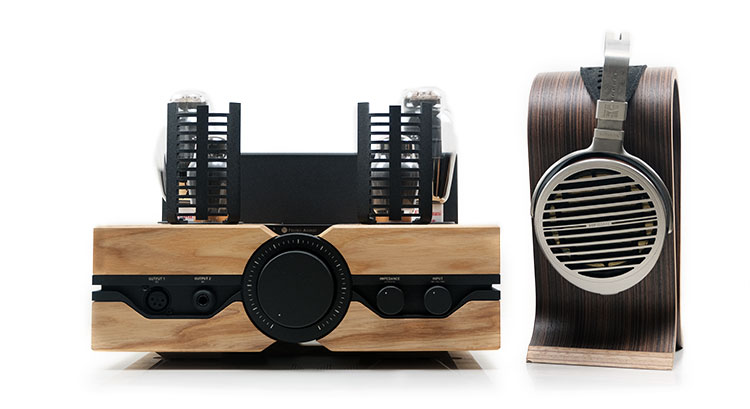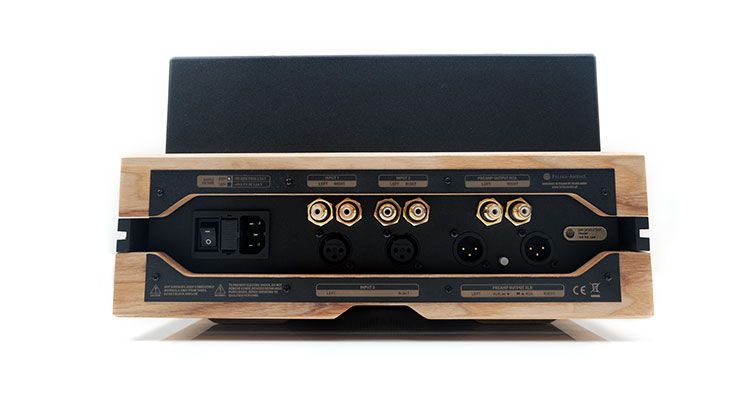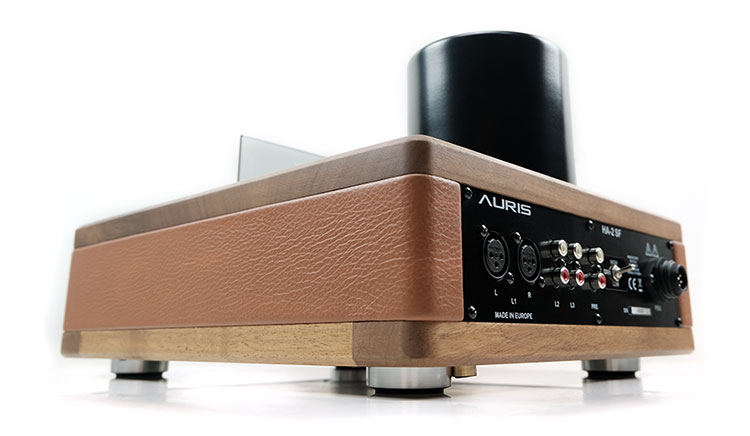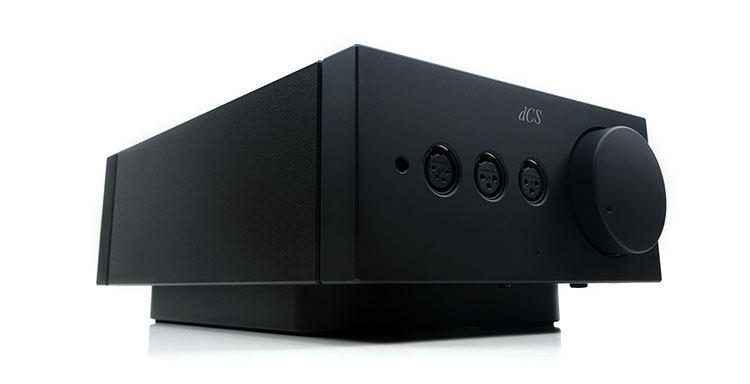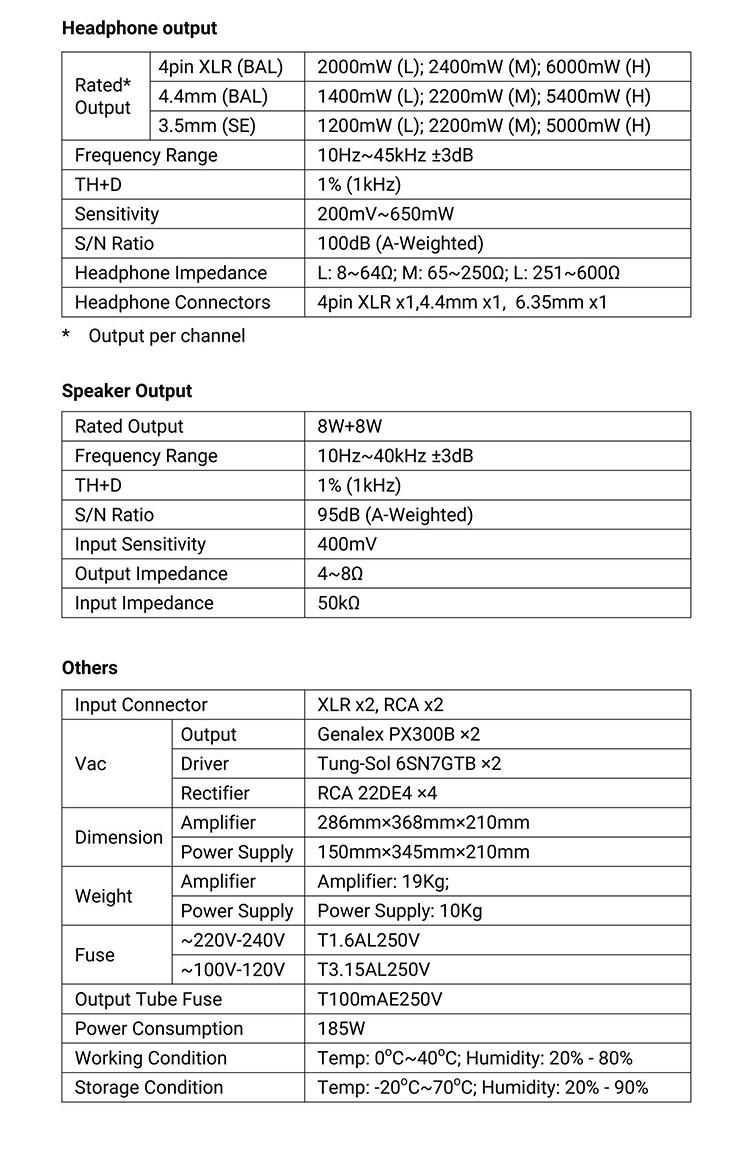Select Comparisons
The following comparisons were completed using a Holo Audio Spring 2 DAC in balanced output mode, a HIFIMAN Susvara, DCA’s Stealth, and the new Abyss Headphones Diana TC.
Feliks Audio Envy
€6499
The Envy was reviewed by us earlier this year and of the 3 compared units this is probably the closest competitor to the HA-300MK2 we have featured thus far.
Technical
I would say this is the closest competitor we have here because like the HA-300MK2, the Envy uses 300B tubes. However, there are some distinct technical differences.
The first is the choice of tubes with the Envy using a matched pair of FullMusic 300B or Electro Harmonix Gold 300B for the power tubes depending on the model. The one we have here is the FullMusic version which is the higher-end model. The HA-300MK2 is a single model with matched Gold Lion Genelex PX300B power tubes.
Both amplifiers use 6N27 driver tubes with the HA-300MK2 equipped with Tung-Sol 6NS7GTB dual-triode tubes and the Envy using PsVane CV-181-T MKII alternatives.
The rectifier design is also quite different. The Envy uses a solid-state rectifier. The power supply for the anode voltage is also designed on semiconductors and based on MOFSET transistors and low-noise current sources.
The HA-300MK2 is more of a classic SET tube-based rectifier using 4 independently wired NOS RCA 22DE4 rectifier tubes and is housed in its own separate similarly styled chassis to reduce interference to the main amplifier.
Both amplifiers are engineered with “point to point” technology meaning each component is directly hard-wired to the next. Also, the two amps offer users a unique impedance matching feature with a similar 3-level system. The Envy is up to 60Ω, 300Ω, and 600Ω whereas the HA-300MK2 has a narrower mid impedance selector from 64Ω to 250Ω but otherwise tops out also at 600Ω
Power
I must point out that Feliks Audio and Cayin have benchmarked their output ratings a little differently with Feliks leading in at a maximum of 8W under a 16Ω load and using unloaded voltage ratings for their own impedance value system.
Cayin has benchmarked mW outputs, (max of 6W), at various impedance switch levels rather than unloaded voltage ratings with target levels of 32Ω (L), 64Ω (M), and 300Ω (H).
I think it is sufficient though to say that overall voltage/current balancing is similar in principle for both amplifiers with more voltage at the high impedance setting and more current at the low impedance mode.
Design
Two incredibly different form factors and looks with the only common denominator being that both amps are heavier than your usual solid-state alternative.
The Envy is the more compact and the lighter of the two amps, however. Its PSU is housed internally but its 15.1kg weight is still more manageable compared to the 19kg of the main HA-300MK2, never mind the additional 10kg of the PSU unit. Given the additional PSU of the Cayin, you will need more rack space to display the HA-300MK2 compared to the Envy.
On an engineering side, I do think the HA-300MK2 material choices and level of detail are of a higher level with those thick aluminum-magnesium plates, expansive grills, glass VU windows, and mechanical switches layout.
However, the ingenuity and cleverness of the oiled woodblocks wrapped around a black aluminum chassis for the Envy are unique and eye-catching in their own right. It looks outwardly simpler but the craftsmanship in integrating the metal and the wood cleanly is of a very high level.
The simplicity translates well to the user interface also with that huge Alps dial front and center with some very clear markings. It is a joy to use and a slight advantage over the much smaller Alps pot of the HA-300MK2.
However, the Envy labeling for me gets very tiny under the Input and Impedance switches making it less useful compared to the superior mechanical switch indicators of the HA-300MK2. Also, who does not love a VU meter on an amp?
I/O
I/O options are also a bit different. The HA-300MK2 is more complete on the front panel for PO with an additional 4.4mm jack and the ability to control output to each jack. The Envy does have a pre-amp option which is missing on the Cayin amplifier but in turn, it lacks a 4.4mm PO.
On the rear, Cayin is all about the direct-to-speaker output whereas the Envy emphasizes its pre-amp output. Feliks does state you can drive speakers with the Envy via the 6.3mm SE PO to connect speakers with a 16Ω impedance to get about 5W of power but it is not as optimal or as powerful as the 8W capable classic speaker posts of the HA-300MK2.
Where the Envy does appear slightly better equipped is the triple line-in at the rear in both SE (2) and balanced (1) whereas the HA-300MK2 only offers a single SE and balanced line-in option.
Performance
Both of these amplifiers can easily drive all three of our test headphones using their respective balanced outputs. However, they do deliver significant technical and thus tonal differences that made me swing to one headphone or another depending on my preferences.
For a start, the Envy is the deeper and more powerful sounding of the two amplifiers. Its solid-state rectification roots shine through with a taut, physical, and more aggressive sub-bass As such, instruments have a slightly shorter decay, a stronger fundamental, and a staging image that is more center-focused to my ear using the Holo Spring DAC.
The HA-300MK2 is nice and punchy but not quite as power-driven in its tuning. Instead, it’s the more holographic and complex-sounding of the two through the mids and airier on the highs.
It is stronger for channel separation, staging width, and classic stereo imaging. It also has more of that classic SET overtone with a sweeter euphonic sound for vocals and a delicate and articulate treble delivery.
Headphone Choices
Of the three headphones, I would pair the Stealth with the Envy and keep its impedance level on high if you want stronger bass. The Envy does a good job encouraging its PRaT to shine through.
The Phi I could go either way with on both amplifiers and just depends on my preference. I loved out the HA-300MK2 built such a complex and wide staging image with a clear separation between the vocals and instruments, teasing out softer cues in the upper register without any sharp overtones. A beautiful pairing for acoustics, jazz, and arena-level music.
Then again, the Envy dug a lot deeper with the Phi, sounding the more rounded in its timbre though a little less air and left-right expansiveness. This pairing does seem to gel better if modern pop and rock are your things.
The Susvara was all about the HA-300MK2 in low or medium impedance mode. It is an articulate, but expansive performer, and for me, the Cayin amp just filled in that massive soundstage that bit better. Again, if you need power and bass energy, go with the Envy. Both are on par for dynamic range and resolution with the Susvara.
Auris Audio HA-2SF
$2499
The Auris Audio HA-2SF was reviewed by us back in 2021 and was also one of our 2021 Top Gear Award amplifier winners.
Technical
Both amplifiers are tube-driven with a Class A bias topology. However, the HA-2SF uses a SE topology with additional balanced I/O more for choice rather than a varied output power capability. The HA-300MK2 does incorporate a balanced output design with variable power ratings for each, including an additional 4.4mm PO output.
Auris does compensate, however, by throwing in pre-amp capabilities and in a nod to its underlying solid-state rectifier a gain switch at the back to run alongside its 3-stage impedance selector. There is no pre-amp on the HA-300MK2 but you can output up to 8W into a 4-8Ω speaker setup directly with those binding posts at the rear.
For the tubes, Auris has opted for four JJ Electronics ECC99 9-pin double triode power tubes and a single input JJ Electronics ECC82 driver tube. The ECC82 is a 12AU7 medium gain pre-amplifying double triode design.
Perhaps not as high level or as expensive as the HA-300MK2 300b tube selection but the ECC99 driver tubes are generally recognized as having excellent current handling capability and good for planar driver synergy.
The two amplifiers split their PSU from the main amplifier. For the HA-2SF, it’s a 3kg linear power supply box with a variable 115V to 230V voltage selector, and for the HA-300MK2 its tube rectifier topology with those 4 independently wired NOS RCA 22DE4 tubes.
Numbers
For the numbers, the HA-2SF does not pack the same punch at 2W into 32Ω. However, that output performance is consistent across both SE and balanced.
Still, the HA-300MK2 is the beefier and the more versatile amp at up to 6W on the high impedance selector dropping down to 1.2W SE on the lowest impedance mode.
There will be some variation also using the HA-2SF’s impedance selector which, like the HA-300MK2, offers 3 different values: low, medium, and high. Auris is less specific on the impedance parameters compared to the older HA-2SE setting but the range is around 32Ω low to 600Ω high.
Design
Like the Envy comparison, the aesthetics and form factor differences between these two are stark, but in a very good way.
The HA-2SF takes the wood theme from the Envy but IMHO it is even more retro in its looks with that pastel-toned leather wrap keeping the more traditional metal housing well out of sight. The front, like the HA-300MK2, is adorned with a set of VU meters though the backlighting is a good deal more intense.
The HA-300MK2 is all about the ‘metal’, being much the bigger and heavier of the two amps but also the better engineered with what seems to be the costlier bill of materials. You could argue both have that retro look but the Cayin unit is a much more imposing design with a different or darker ‘aura’ to its aesthetics.
I also prefer the positioning of the controls on the HA-300MK2 which are on the front panel as opposed to the top of the HA-2SF. From a headphone user’s perspective, it is much easier to quickly read and adjust whereas with the HA-2SF I have to stand up and over it to make controlled changes.
For I/O, the HA-2SF is closer to the Envy in functionality with its pre-amp out and triple deck of inputs including 2 SE dual RCA and a single XLR input. Both are SE in terms of signal management from input to output despite having a 4-pin XLR PO option.
The HA-300MK2 is missing the pre-amp and has fewer inputs but the inputs are SE and balanced in operation and it also offers a direct connection to a set of speakers.
Performance
For Susvara owners the power disparity between these two is probably where you want to start with.
The HA-2SF 2W in high gain struggled a little in terms of dynamic range and being able to fill out the Susvara’s vast soundstage compared to the 6W on tap from the balanced output of the HA-300MK2.
The potentiometer was almost at full stretch and impedance at high to get some zest into the Susvara pairing. Whereas the HA-300MK2 was quite happy on medium or even low impedance with the volume set to around 1-2 pm on its balanced output.
The Diana Phi came a close second in terms of stretching out the HA-2SF handling capability with the dial around 3 pm but the headroom was much better. The same is true for the Stealth which seemed to need similar levels of gain and volume. Neither gives the HA-300MK2 any driving issues.
Technically, the HA-2SF is the more neutral in terms of staging and tonal coloration. It has a little less of that sweet and light touch of the HA-300MK2 from the upper mids onwards, particularly with the Phi and a more rounded mids timbre with a more forward vocal image.
I suspect the vocal image is just the most salient aspect of a soundstage that felt more intimate in general. Kind of like a well-padded studio room compared to a concert hall experience with these two amps. The HA-300MK2 pulled the vocals back a little but complemented it with stronger depth behind the vocal and positioned instrumental imaging further out.
You could argue the HA-300MK2 is the more relaxed and roomier of the two because on certain tracks the HA-2SF did sound slightly more aggressive for sub-bass but not on the same level as the Envy.
dCS Lina Headphone Amplifier
$9,100
An early preview comparison of sorts with a full review out in the coming weeks but well worth a short comparison at this stage. Just note, that my overall impression might be tweaked by the time we get to the full feature
Technical
The Lina is a very different proposition from the HA-300MK2. It is a solid-state pure headphone amplifier as opposed to SET and uses a bespoke Class AB amplification topology with a DC server system as opposed to Class A with a tube rectifier.
The key aspect or driver for dCS was the requirement to combine the efficiency of Class AB with the linear performance of Class A. Hence, the bespoke design focuses on error voltage correction during the handover between the positive and negative power devices
Both amplifiers have a provision for SE and balanced analog inputs and PO outputs. The type of PO does differ with the Lina amp offering 6.35mm SE, balanced 4-pin, and dual left/right 3-pin XLR balanced options.
The HA-300MK2 also offers a 6.35mm SE PO and a 4-pin XLR balanced socket but is slightly more IEM or modern audiophile friendly with the inclusion of a 4.4mm port.
The Lina has no impedance selection capability and like the HA-300MK2 it does not offer a pre-amp either. However, this is a modular unit and can be controlled via a network RJ45 interface which links it to the Lina DAC and a World Clock system. That means you can wake the entire system via the dCS Lina remote Mosaic app.
It also has two types of balanced analog inputs, a buffered version for 3rd party sources and an unbuffered version specifically for the Lina DAC. The HA-300MK2 makes no such distinction with the added bonus of speaker taps if you want to integrate it as a HiFi amplifier.
Numbers
For such a high-end amplifier the balanced 2W into a 32Ω load might come as a bit of a surprise for potential Lina users.
Granted, the Bartok was no different and its headroom is much better than you might think but compared to the 6W balanced (H) from the HA-300MK2 it seems somewhat understated.
Instead, this match-up is all about the noise floor and just how low the distortion will be, and usually a good solid-state will perform better on paper for sensitive gear. The Lina does offer 10dB more for its SNR rating and its THD+N is benchmarked at <0.005% @1kHz into 30Ω compared to 1% into the same 1kHz weighting from the HA-300MK2.
Design
The Lina headphone amplifier is minimalist, urban-styled, and thoroughly modern in looks and a complete contrast to the heavily-engineered classic retro looks of the HA-300MK2, complete with VU and tube glow accents.
The Cayin design is a plethora of options with switches for impedance, source, and outputs. The Lina is a monolithic black slab with the only visual being a huge and beautifully finished potentiometer on the front panel and a tiny LED indicator. Power and gain controls are hidden under the main body and something which you might not even see.
With the HA-300MK2 you see everything, nothing is hidden, Cayin wants you to see and experience every visual motif whatever the angle you sit at.
Since everything is integrated into the Lina, the amp itself is fairly compact though not exactly small or lightweight in its own right. Still, compared to the HA-300MK2 it is a featherweight class contender at 7.5kg compared to 19kg for the main Cayin tube amplifier alone.
Performance
This is solid state high-end versus SET high-end with the Lina amp masterful in terms of perceived articulation and control, with excellent dynamic range over a very black background.
The tone is neutral to natural, not overly dry by solid-state standards but drier than the HA-300MK2 liquid-like delivery and euphonic sweeter timbre. The notes via the Lina are shorter on decay and with more attack emphasis giving it a much more aggressive sound signature despite it actually not being that bass-heavy.
The HA-300MK2 is more relaxed and not quite as fizzy on the top end. I would say both are excellent for staging width with the Lina the more transparent and the more precise of the two through the mids also.
The Cayin presentation for timbre is definitely the more inviting, intoxicating if you will, with a creamier smoother delivery. It also offers a bit more bass bloom and slightly longer decay levels with our chosen pairings.
It is the more forgiving of the two amps, with that classic SET richness in instrumental and vocal timbre. If you want the last drop of detail, the Lina stands above. Given those two statements, we had some distinct preferences for the headphone pairings.
Headphone Choices
On that headphone preference point, this is where I felt something like the Stealth was a better match with the HA-300MK2 than with the Lina.
The Lina tended to tease out a stronger upper mids and lower treble that was perhaps too hard-edged and not enough warmth on the low-end to compensate.
The HA-300MK2 was more forgiving and a more natural-sounding pairing. The mids felt a little smoother, maybe not quite as micro-detailed but the over-coloration and less aggressive imaging felt easier on the ear for longer listening sessions.
The Abyss Headphones TC, on the other hand, was perfect with the Lina. It’s the type of clean and very fast planar driver that mirrors the hyper-detailed technical ability of the Lina. You get a smoother tone with the HA-300MK2 but it is not as revealing though I dare say vocal lovers will still find the smooth delivery quite agreeable.
Arguably the stronger nominal output of the HA-300MK2 will give you a bit more power with the likes of the Susvara pairing. However, I found the Lina amp to cope quite well with the Susvara and our other two headphones using the high gain mode via its balanced output.
Our Verdict
The Cayin HA-300MK2 is a fabulous sounding 300B SET flagship headphone amplifier. It has that classic slightly sweet emotive coloration combined with a seriously impressive holographic staging quality. Neither does it lack power for demanding headphones so dynamic range is never going to be an issue.
It is also beautifully engineered, though being a Cayin 2nd gen design I am not terribly surprised. They have had years to nail this attractive design so the level of engineering is clearly world-class. It is a heavy unit though at 29kg including the rectifier so do make sure you have enough space and support on your rack.
Unless your preference is for a headphone tuned specifically for lighting fast articulation and deep rumbling bass, it’s going to be very hard to find a pairing that doesn’t sound very pleasing with this high-end amplifier.
Cayin HA-300MK2 Specifications


